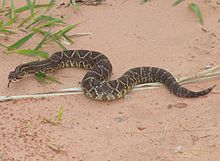Chill rattlesnake
| Chill rattlesnake | ||||||||||||
|---|---|---|---|---|---|---|---|---|---|---|---|---|

Shiver rattlesnake ( Crotalus durissus cumanensis ) |
||||||||||||
| Systematics | ||||||||||||
|
||||||||||||
| Scientific name | ||||||||||||
| Crotalus durissus | ||||||||||||
| Linnaeus , 1758 |
The shiver rattlesnake ( Crotalus durissus ), also known as cascabel or tropical rattlesnake , is the only type of rattlesnake ( Crotalus ) that is found on the South American continent. It occurs with several subspecies in the dry forest areas and the steppe areas from Mexico to Argentina and thus has the largest distribution area of all rattlesnake species.
features
The shower rattlesnake is a comparatively large rattlesnake with an average body length of one meter. Individual individuals can be 1.50 meters long. In terms of color and scaling, the species is very variable depending on the respective subspecies and regional distribution, which means that a general description is not possible. The variation of the basic color ranges from yellow to red, green, olive green, brown, light and dark gray to black. The drawing on the back usually consists of spots with a diamond shape, the diamonds, which can also dissolve into a pattern of spots or a band of drawings ( e.g. with the subspecies C. d. Vegrandis ). It can be darker than the basic color in the same shade or in a different color or black. In addition, there are animals in which the spots have the same color as the basic color, so the back markings are only clear through the slightly lighter border, as well as those without back markings, such as in the case of C. unicolor who lives in Aruba .
The head markings are less variable, although there are also individual subspecies with different characteristics. As a rule, it consists of two clear, parallel stripes from the top of the head to the neck, which are the same color as the pattern on the back, and an eye stripe that runs over the eyes to the corners of the mouth.
distribution and habitat
The range of the snake extends from southern Mexico over Central America to Argentina . However, this is not a continuous distribution area, as the snake avoids the rainforest areas. So far, no evidence of the snake has been made in Panama , which separates the Central American populations from those in northern South America. The rainforests in the Amazon basin in central South America are also not colonized by it, which leads to a separation of the populations in northern South America and those south of the Amazon. The subspecies on the islands off the coast of Venezuela are also isolated .
The habitat of the shower rattlesnake is characterized by dry forest areas and grass steppes, while it avoids closed forests, swamps and the South American rainforest. In some areas, however, the snake was found on small dry areas surrounded by rainforest and thus isolated.
Snake venom
The poison of the shower rattlesnake varies greatly in its composition and effect regionally and depending on the subspecies. The poison of some subspecies is similar in its composition to the poisons of the Mexican and North American rattlesnakes and is therefore mainly characterized by tissue-destroying proteins. The effect consists mainly of tissue destruction, local painful swellings and hemorrhagic effects. The poison of the South American C. d. terrificus , on the other hand, contains mainly neurotoxic components that act on the central nervous system and lead to paralysis , shock , failure of nerve supplies to central organs and kidney failure - local pain and swelling are hardly present.
Especially snake bites of the C. d. terrificus are very often fatal with a mortality of up to 75 percent within a short time, while medical help and the administration of an antidote are often possible with bites of other subspecies.
Systematics
Currently, depending on the source, a distinction is made between 9 to 14 subspecies of the shower rattlesnake, some of which have very large distribution areas such as B. the nominate form C. d. durissus and the South American C. d. terrificus , but mostly restricted to small-scale areas as endemic subspecies. A distinction is made between:
- C. d. cudminatus in southwestern Mexico
- C. d. cumanensis in Colombia and the coastal regions of Venezuela
- C. d. durissus along the northeast coast of South America.
- C. d. marajoensis on the Brazilian island of Marajó
- C. d. ruruima in the area of Mount Roraima near the border of Venezuela and Brazil
- C. d. terrificus in large parts of South America from southeastern Peru to the Atlantic coast of Brazil and south in central and southern Argentina
- C. d. trigonicus in southwestern Guyana and adjacent regions
- C. d. tzabcan on the Yucatán Peninsula in Mexico and adjacent regions of Guatemala and Belize
- C. d. unicolor on the island of Aruba off the coast of Venezuela
- C. d. vegrandis in eastern Venezuela
C. d. unicolor and C. d. vegrandis are often viewed as a separate species. Crotalus totonacus and Crotalus simus were relocated as separate species , the latter being listed as a nominate form until 2004.
literature
- Chris Mattison: Rattlers! - A natural history of rattlesnakes . Blandford, London 1996, ISBN 0-7137-2534-6 .
Web links
- Crotalus durissus in The Reptile Database
- Crotalus durissus inthe IUCN 2013 Red List of Threatened Species . Posted by: Martins, M. & Lamar, WW, 2009. Retrieved October 5, 2013.


